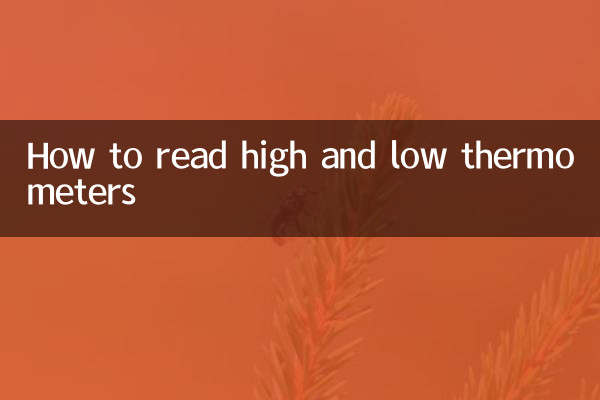How to read high and low thermometers
High and low thermometers are instruments used to record the highest and lowest temperatures over a period of time, and are widely used in meteorological, agricultural, industrial and other fields. Correct reading of the values of high and low thermometers is crucial for data analysis. This article will introduce in detail the structure, reading methods of high and low thermometers, and recent hot topics on the entire network to help you better understand and use this tool.
1. Structure and principle of high and low thermometer

A high and low thermometer is usually composed of two parts: the highest thermometer and the lowest thermometer. The highest thermometer uses mercury as the temperature measurement medium, while the lowest thermometer uses alcohol. The working principle of the two is slightly different:
| type | Temperature measurement medium | How it works |
|---|---|---|
| Maximum thermometer | mercury | Mercury expands under heat, pushing the pointer up, and after cooling, the pointer stays at the highest temperature point |
| Minimum thermometer | Alcohol | Alcohol is cold and shrinks, causing the pointer to fall. After the temperature rises, the pointer stays at the lowest temperature point. |
2. How to correctly read the value of a high and low thermometer
Reading the value of a high and low thermometer requires following the following steps:
1.Observe the position of the thermometer:Make sure the thermometer is placed horizontally to avoid reading errors caused by tilting.
2.Read the maximum temperature:Check the top position of the mercury column in the highest thermometer, and the corresponding scale is the highest temperature.
3.Read the minimum temperature:Check the bottom end position of the alcohol column in the lowest thermometer, and the corresponding scale is the lowest temperature.
4.Record data:Record the read values in a table for easier subsequent analysis.
Here is an example reading record table:
| date | Maximum temperature (℃) | Minimum temperature (℃) |
|---|---|---|
| 2023-10-01 | 28 | 15 |
| 2023-10-02 | 26 | 14 |
| 2023-10-03 | twenty four | 12 |
3. Recently, popular topics and hot content on the entire network
The following are hot topics and hot contents on the Internet in the past 10 days, covering multiple fields such as technology, society, and entertainment:
| Hot Topics | Popularity index | Main discussion content |
|---|---|---|
| New breakthrough in artificial intelligence | ★★★★★ | A technology company released a new generation of AI models, attracting widespread attention |
| Global climate change | ★★★★☆ | Extreme weather events occur frequently, countries step up response measures |
| The movie "Oppenheimer" is released | ★★★☆☆ | Nolan's new film sparked heated discussion among audiences and strong box office performance |
| A divorce incident of a certain celebrity | ★★★☆☆ | Another star in the entertainment industry announces divorce, social media furious |
4. Maintenance and precautions for high and low thermometers
In order to ensure the accuracy and service life of high and low thermometers, the following points need to be paid attention to:
1.Regular calibration:It is recommended to calibrate the thermometer every six months to ensure accurate readings.
2.Avoid violent vibrations:The thermometer has a precise internal structure and violent vibrations may cause the pointer to be displaced or damaged.
3.Cleaning and maintenance:Wipe the surface of the thermometer regularly with a soft cloth to avoid dust and stains affecting the reading.
4.Storage environment:Thermometers should be stored in a dry and ventilated environment to avoid direct sunlight.
V. Conclusion
High and low thermometers are a simple but practical tool. Correct reading and recording data are of great significance to meteorological research, agricultural production, etc. Through the introduction of this article, I hope you can better master the use of high and low thermometers, and combine them with recent hot topics to broaden your knowledge horizons.
If you have more questions about high and low thermometers or other scientific instruments, please leave a message to discuss!

check the details

check the details